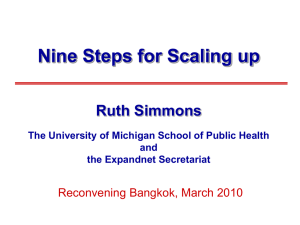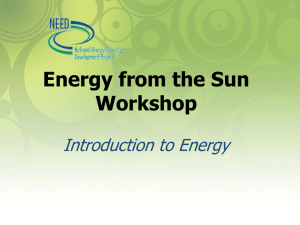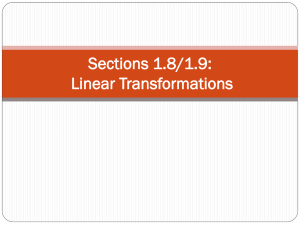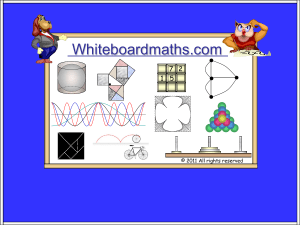Chapter 7
advertisement
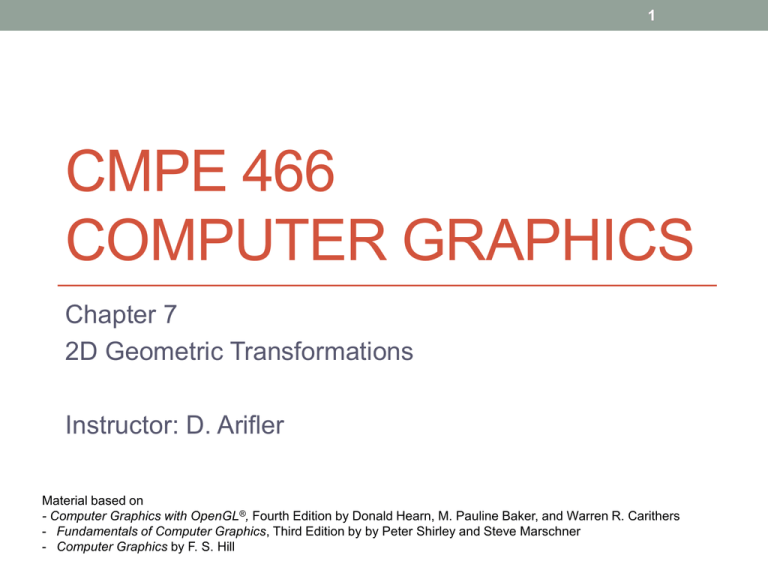
1 CMPE 466 COMPUTER GRAPHICS Chapter 7 2D Geometric Transformations Instructor: D. Arifler Material based on - Computer Graphics with OpenGL®, Fourth Edition by Donald Hearn, M. Pauline Baker, and Warren R. Carithers - Fundamentals of Computer Graphics, Third Edition by by Peter Shirley and Steve Marschner - Computer Graphics by F. S. Hill 2 Basic geometric transformations • Translation • Rotation • Scaling 3 2D translation Figure 7-1 Translating a point from position P to position P’ using a translation vector T. 4 2D translation equations Translation is a rigid-body transformation: Objects are moved without deformation. 5 2D translation example Figure 7-2 Moving a polygon from position (a) to position (b) with the translation vector (−5.50, 3.75). 6 2D translation example program 7 2D rotation • All points of the object are transformed to new positions by rotating the points through a specified rotation angle about the rotation axis (in 2D, rotation pivot or pivot point) Figure 7-3 Rotation of an object through angle θ about the pivot point (xr , yr ). 8 2D rotation Figure 7-4 Rotation of a point from position (x, y ) to position (x', y' ) through an angle θ relative to the coordinate origin. The original angular displacement of the point from the x axis is Φ. Setting we have 9 2D rotation in matrix form Equations can be compactly expressed in matrix form: Rotation is a rigid-body transformation: Objects are moved without deformation. 10 Rotation about a general pivot point Figure 7-5 Rotating a point from position (x , y ) to position (x' , y' ) through an angle θ about rotation point (xr , yr ). 11 2D rotation example 12 2D scaling sx and sy are scaling factors sx scales an object in x direction sy scales an object in y direction If sx=sy, we have uniform scaling: Object proportions are maintained. If sx≠sy, we have differential scaling. Negative scaling factors resizes and reflects the object about one or more of the coordinate axes. 13 2D scaling Figure 7-6 Turning a square (a) into a rectangle (b) with scaling factors sx = 2 and sy = 1. Scaling factors greater than 1 produce enlargements. 14 2D scaling Figure 7-7 A line scaled with Equation 712 using sx = sy = 0.5 is reduced in size and moved closer to the coordinate origin. Positive scaling values less than 1 reduce the size of objects. 15 Scaling relative to a fixed point Figure 7-8 Scaling relative to a chosen fixed point (xf , yf ). The distance from each polygon vertex to the fixed point is scaled by Equations 7-13. Fixed point remains unchanged after the scaling transformation. 16 2D scaling relative to a fixed point 17 2D scaling example 18 Matrix representations and homogeneous coordinates • Multiplicative and translational terms for a 2D transformation can be combined into a single matrix • This expands representations to 3x3 matrices • Third column is used for translation terms • Result: All transformation equations can be expressed as matrix multiplications • Homogeneous coordinates: (xh, yh, h) • Carry out operations on points and vectors “homogeneously” • h: Non-zero homogeneous parameter such that • We can also write: (hx, hy, h) • h=1 is a convenient choice so that we have (x, y, 1) • Other values of h are useful in 3D viewing transformations 19 2D translation matrix 20 2D rotation matrix 21 2D scaling matrix 22 Inverse transformations Inverse translation Inverse rotation Inverse scaling 23 Composite transformations • Composite transformation matrix is formed by calculating the product of individual transformations • Successive translations (additive) 24 Composite transformations • Successive rotations (additive) • Successive scaling (multiplicative) 25 2D pivot-point rotation Figure 7-9 A transformation sequence for rotating an object about a specified pivot point using the rotation matrix R(θ) of transformation 7-19. 26 2D pivot-point rotation Note the order of operations: 27 2D fixed-point scaling Figure 7-10 A transformation sequence for scaling an object with respect to a specified fixed position using the scaling matrix S(sx , sy ) of transformation 7-21. 28 2D fixed-point scaling 29 Matrix concatenation properties • Multiplication is associative • Multiplication is NOT commutative • Unless the sequence of transformations are all of the same kind • M2M1 is not equal to M1M2 in general 30 Computational efficiency • Formulation of a concatenated matrix may be more efficient • Requires fewer multiply/add operations • Rotation calculations require trigonometric evaluations • In animations with small-angle rotations, approximations (e.g. power series) and iterative calculations can reduce complexity 31 More on 2D rotation Figure 7-14 The rotation matrix for revolving an object from position (a) to position (b) can be constructed with the values of the unit orientation vectors u' and v' relative to the original orientation. Assign the elements of u’ to the first row of the rotation matrix and the elements of v’ to the second row. 32 Other transformations: reflection Figure 7-16 Reflection of an object about the x axis. 33 Reflection Figure 7-17 Reflection of an object about the y axis. 34 Reflection Figure 7-18 Reflection of an object relative to the coordinate origin. This transformation can be accomplished with a rotation in the xy plane about the coordinate origin. 35 Reflection Figure 7-19 Reflection of an object relative to an axis perpendicular to the xy plane and passing through point Preflect. 36 Reflection Figure 7-20 Reflection of an object with respect to the line y = x . 37 Other transformations: shear • Distorts the shape of an object such that the transformed shape appears as if the object were composed of internal layers that had been caused to slide over each other Figure 7-23 A unit square (a) is converted to a parallelogram (b) using the x -direction shear matrix 7-57 with shx = 2. 38 Shear Figure 7-24 A unit square (a) is transformed to a shifted parallelogram (b) with shx = 0.5 and yref = −1 in the shear matrix 7-59. 39 Shear Figure 7-25 A unit square (a) is turned into a shifted parallelogram (b) with parameter values shy = 0.5 and xref = −1 in the y -direction shearing transformation 7-61. 40 Transformations between 2D coordinate systems Figure 7-30 A Cartesian x' y' system positioned at (x0, y0) with orientation θ in an xy Cartesian system. Figure 7-31 Position of the reference frames shown in Figure 7-30 after translating the origin of the x' y' system to the coordinate origin of the xy system. 41 Transformations between coordinate systems 42 Alternative method Figure 7-32 Cartesian system x' y' with origin at P0 = (x0, y0) and y' axis parallel to vector V. 43 Transformations Figure 7-33 A Cartesian x ' y' system defined with two coordinate positions, P0 and P1, within an xy reference frame. 44 OpenGL matrix operations • glMatrixMode ( GL_MODELVIEW ) • Designates the matrix that is to be used for projection transformation (current matrix) • glLoadIdentity ( ) • Assigns the identity matrix to the current matrix • Note: OpenGL stores matrices in column-major order • Reference to a matrix element mjk in OpenGL is a reference to the element in column j and row k • glMultMatrix* ( ) post-multiplies the current matrix • In OpenGL, the transformation specified last is the one applied first 45 OpenGL transformation example 46 OpenGL transformation example Figure 7-34 Translating a rectangle using the OpenGL function glTranslatef (−200.0, −50.0, 0.0). 47 OpenGL transformation example Figure 7-35 Rotating a rectangle about the z axis using the OpenGL function glRotatef (90.0, 0.0, 0.0, 1.0). 48 OpenGL transformation example Figure 7-36 Scaling and reflecting a rectangle using the OpenGL function glScalef (−0.5, 1.0, 1.0).



